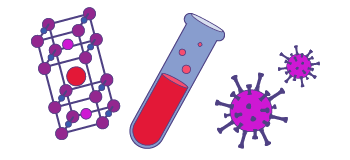In the pulse-echo ultrasonic technique, an ultrasound wave is excited and detected by two identical piezoelectric transducers (transmitter and receiver), which are glued to polished opposite sides of a sample.
When a burst of an rf signal is applied to the transmitter, the latter generates an ultrasound pulse with the same duration. This ultrasound pulse propagates across the sample and, when it arrives at the receiver transducer, generates an rf pulse. The ultrasound pulse propagates back and forth and creates additional rf pulses at the receiver—a so called “echo train.” The sound propagation time is determined by the sound velocity and hence by the associated elastic constant. The time evolution of the amplitude of the received pulse is defined by the sound attenuation. Both the ultrasound velocity and attenuation are intrinsic properties of the material and can be changed only by varying some external parameters such as temperature, magnetic field or pressure, for example. Investigation of a relative change of the velocity and attenuation on these external parameters is implemented at the MagLab.
Resistive Magnets
Superconducting Magnets
Hybrid Magnets

Explore our magnet schedule to see what exciting research is happening on our stellar fleet of instruments right now.
Nomura, T., et al., Enhanced spin correlations in the Bose-Einstein condensate compound Sr3Cr2O8, Physical Review B , 102, 165144 (2020) Read online.
Grossmann, J., et al., Highly sensitive simple homodyne phase detector for ultrasonic pulse-echo measurements, Review of Scientific Instruments, 87, 4, 044901 (2016) Read online.
O. Svitelskiy, et al., Influence of hydrostatic pressure on the magnetic phase diagram of superconducting Sr2RuO4 by ultrasonic attenuation, Phys. Rev. B (2008) Read online.
O. Svitelskiy, et al., Elastic properties of Gd5(Si2Ge2) studied by ultrasonic pulse-echo technique, Phys. Rev. B 74 (2006) Read online.
A. Suslov, et al., Ultrasonic instrumentation for measurements in high magnetic fields. Part I: continuous magnetic fields, Review of Scientific Instruments 77 (2006) Read online.
Last modified on 13 December 2023